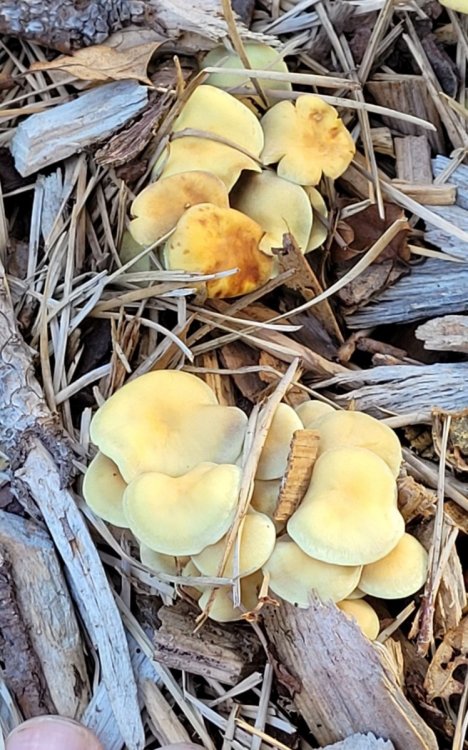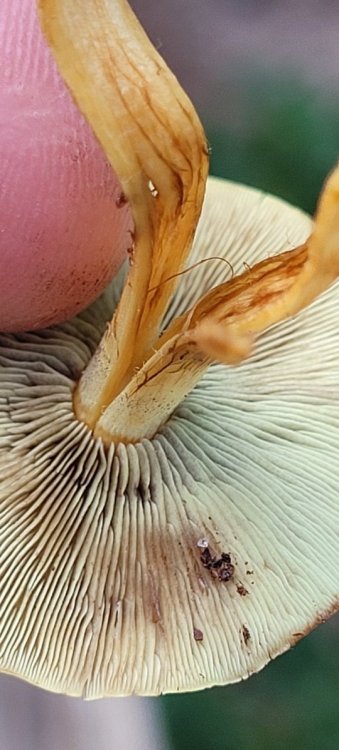

nonada
Members-
Posts
38 -
Joined
-
Last visited
Everything posted by nonada
-
Interesting, "Common Macrofungi in Eastern Forests and Their Ecosystem Functions Michael E. Ostry Neil A. Anderson Joseph G. O’Brien" shows brunnescens occuring near tamarack or black spruce, but other sources show it with the associations you suggest.
-
Thanks for the info, very interesting.
-
Brunnescens is mycorrhizal with tamarack or black spruce, right?
-
Rbenn, what program are you using in that screenshot? Very handy.
-

Hi again, Yard mushroom again, ID please?
nonada replied to ooOOoOooOoOo's topic in Identifying Mushrooms
Could this be a. Brunnescens? I dont know if you have tamaracks or black spruce nearby, it seems like it would be rather far south for either tree. -
Thank you very much. I was not able to obtain a spore print from the original. I will try for a print if I find one again.
-
Yellow cap. Growing in clumps on woodchips in massachusetts. Spore appears purplish brown. Cap and stem stain brown when injured. Smells slightly musty. Largest single cap about 2 or 3 cm.
-
Growing prolifically on woodchips in massachusetts. Faintly musty smell. spore appears orange Hollow stem. Gills appear to stain brown when injured.
-
Thank you very much for taking the time to explain. I appreciate your help and attention as I try to learn to identify the species growing nearby.
-

white mushroom in sandy gravel massachusetts
nonada replied to nonada's topic in Identifying Mushrooms
I tried--had to leave it ouside because it smells(dont know about the gym socks odor people describe, but close I suppose, and certainly pungent) it is very damp. Spore looks white to light yellow -

Armillaria mellea? yellow mushroom cluster under white pine
nonada replied to nonada's topic in Identifying Mushrooms
Yes, certainly new to them. I have read that about boiling before. I appreciate the advice, esp. regarding alcohol. I know this much: I should never assume I will not have a reaction to a mushroom (or anything i consume) simply because others eat it with no ill effect. -

Armillaria mellea? yellow mushroom cluster under white pine
nonada replied to nonada's topic in Identifying Mushrooms
Will do, very wet right now. -

Hypholoma lateritium ? cluster of brown/gold mushrooms on stump
nonada replied to nonada's topic in Identifying Mushrooms
Heres an update a few days later. While im not sure it is Hypholoma lateritium, trying to rule out poisonous lookalikes to Hypholoma lateritium. As you suggested, the dark purple spore is clearly visible. Thanks! -

Armillaria mellea? yellow mushroom cluster under white pine
nonada replied to nonada's topic in Identifying Mushrooms
-

Red Pored Bolete identification appreciated
nonada replied to NNKVirginia's topic in Identifying Mushrooms
I'm not experienced enough to offer any suggestions, but have you tried the bolete filter? https://boletes.wpamushroomclub.org/ -

white mushroom in sandy gravel massachusetts
nonada replied to nonada's topic in Identifying Mushrooms
Could this be an amanita, or a Tricholoma murrillianum? -

Hypholoma lateritium ? cluster of brown/gold mushrooms on stump
nonada replied to nonada's topic in Identifying Mushrooms
So the spores are purple. How much does that help to narrow it down? Id like to rule out poisonous varieties like Hypholoma fasciculare if possible. -
Does not appear to stain or exude milk when gills injured. Stem may stain fractionlly darker when bruised Growing in open, 20ft from oak and pine Smells a little like chlorine and a locker room Spore white
-
Thanks for taking the time to respond. There are many of these near me and I am interested in identifying. I will try to get a spore print.
-
Could this be Russula adusta?
-
This was cut. I later broke it horizontally to see how it snapped. It is currently too wet for a spore print. Thanks for response. I am not able to confidently differentiate between Russula and tricholoma.
-
Could it be Tricholoma transmutans or tricholoma equestre?
-

Hypholoma lateritium ? cluster of brown/gold mushrooms on stump
nonada replied to nonada's topic in Identifying Mushrooms
Ha! That was a quite a coincidence! You are right about the lighting, the gills are whiter in daylight. Thanks for the response. It is so wet here that im having trouble drying them naturally for a spore print. -

Hypholoma lateritium ? cluster of brown/gold mushrooms on stump
nonada replied to nonada's topic in Identifying Mushrooms
Just saw a picture and thought maybe Hypholoma lateritium.















